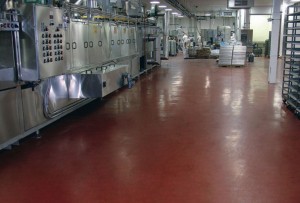Floor Topping Is Icing on Bakery's Expansion Projects
 When Hill Country Bakery of San Antonio, TX, purchased a nearby facility for the pur- pose of expanding its manufacturing capabilities, it selected a polyurethane-modified concrete flooring system to provide resistance to thermal cycling, impact, abrasion, and constant cleaning, says Steve O’Donnell, managing partner of the company. The company has used the flooring system in sever- al projects, including this first expansion in 2005 and its second expansion, which was completed in 2007. Given his past experience with older epoxy flooring technology, which failed after a year in service in a similar project for another bakery, O’Donnell believes his choice of polyurethane-modified con- crete is a good one. “I look at the long-term big pic- ture. I don’t want to put something down, get into production, and have the floor come up in a year or two,” he says.
When Hill Country Bakery of San Antonio, TX, purchased a nearby facility for the pur- pose of expanding its manufacturing capabilities, it selected a polyurethane-modified concrete flooring system to provide resistance to thermal cycling, impact, abrasion, and constant cleaning, says Steve O’Donnell, managing partner of the company. The company has used the flooring system in sever- al projects, including this first expansion in 2005 and its second expansion, which was completed in 2007. Given his past experience with older epoxy flooring technology, which failed after a year in service in a similar project for another bakery, O’Donnell believes his choice of polyurethane-modified con- crete is a good one. “I look at the long-term big pic- ture. I don’t want to put something down, get into production, and have the floor come up in a year or two,” he says.
Facility Retrofit
Hill Country’s first project comprised the retrofitting of a building to accom- modate tunnel ovens, which increase productivity but which also subject the surrounding flooring to extreme temperature fluctuations. According to John Guidry, vice president of business development for the coating contractor, his company recommended the polyurethane-modified concrete f loor topping because the thick-film system would offer better wearing, greater resistance to impact and thermal cycling, and longer service life than typical epoxy floor coatings. The existing concrete was in generally good shape, says O’Donnell, but the areas that would support the tunnel ovens were removed and replaced to meet the weight demands of the equipment. In this project, the contractor pre- pared and resurfaced approximately 20,000 sq ft (1,858 sq m) of concrete and 1,600 lineal feet (488 m) of coving, says Guidry.
